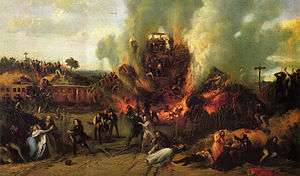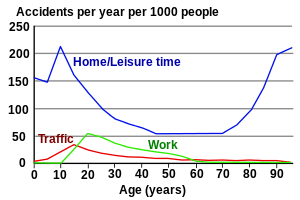Accident
An accident, also known as an unintentional injury, is an undesirable, incidental and unplanned event that could have been prevented had circumstances leading up to the accident been recognized, and acted upon, prior to its occurrence. Most scientists who study unintentional injury avoid using the term "accident" and focus on factors that increase risk of severe injury and that reduce injury incidence and severity (Robertson, 2015).
Types

Physical and non-physical
Physical examples of accidents include unintended motor vehicle collisions or falls, being injured by touching something sharp, hot, electrical or ingesting poison. Non-physical examples are unintentionally revealing a secret or otherwise saying something incorrectly, forgetting an appointment etc.
By activity
- Accidents during the execution of work or arising out of it are called work accidents. According to the International Labour Organization (ILO), more than 337 million accidents happen on the job each year, resulting, together with occupational diseases, in more than 2.3 million deaths annually.[1]
- In contrast, leisure-related accidents are mainly sports injuries.
By vehicle

Common causes

Poisons, vehicle collisions and falls are the most common causes of fatal injuries. According to a 2005 survey of injuries sustained at home, which used data from the National Vital Statistics System of the United States National Center for Health Statistics, falls, poisoning, and fire/burn injuries are the most common causes of death.[2]
The United States also collects statistically valid injury data (sampled from 100 hospitals) through the National Electronic Injury Surveillance System administered by the Consumer Product Safety Commission.[3] This program was revised in 2000 to include all injuries rather than just injuries involving products.[3] Data on emergency room visits is also collected through the National Health Interview Survey.[4] In The U.S. the Bureau of Labor Statistics has available on their website extensive statistics on workplace accidents.[5]
Accident models
Many models to characterize and analyze accidents have been proposed, listed and referenced in this reference.[6]
See also
General
Transportation
Other specific topics
References
Robertson, LS. Injury Epidemiology: Fourth Edition. Free online at www.nanlee.net
- ↑ "ILO Safety and Health at Work". International Labour Organization (ILO)
- ↑ Runyan CW, Casteel C, Perkis D, et al. (January 2005). "Unintentional injuries in the home in the United States Part I: mortality". Am J Prev Med. 28 (1): 73–9. doi:10.1016/j.amepre.2004.09.010. PMID 15626560.
- 1 2 CPSC. National Electronic Injury Surveillance System (NEISS). Database query available through: NEISS Injury Data.
- ↑ NCHS. Emergency Department Visits. CDC.
- ↑ http://www.bls.gov/iif
- ↑ Taylor, G.A., Easter, K.M., Hegney, R.P. (2004). Enhancing Occupational Safety and Health. Elsevier. pp. 241–245, see also pages 140–141 and pages 147–153, also on Kindle. ISBN 0750661976.
External links
| Wikiquote has quotations related to: Accident |
| Wikimedia Commons has media related to Accidents. |